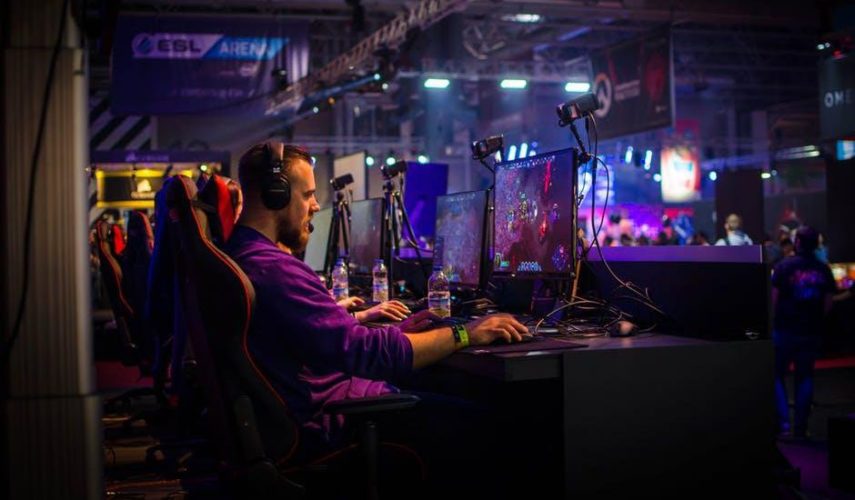Other
The Future of eSports and New Technologies

eSports have experienced tremendous growth in recent years. It got more professionals training in academies or clubs, higher revenues for competitions, and new technologies that soon point to an even more major boom.
The eSports industry is relatively new for the general public, but it is consolidated worldwide. And the future of eSports looks promising, with a full expansion in different regions of the planet. It is normal to enter sports betting sites and find a whole menu of events related to video games such as Dota 2, Counter-Strike, Call of Duty, Starcraft or Rainbow Six.
With the Covid-19 pandemic, entertainment and leisure options were reduced for many months, leading people to pay more attention to eSports and slots not on Gamstop. Significant eSports tournaments bring together ‘gamers’ from all over the world, people who have a professional approach to the activity and receive salaries and prizes in the millions.

More professional eSports
The path to the professional level of eSports has been much faster than in other areas, thanks in large part to the sponsors that international competitions attract. As a result, the video game industry is very productive and has multiple different markets and additional branches that generate indirect income for the companies that dominate the global scene.
For some time now, there have been academies or clubs to train e-sports professionals in different countries with a specialised preparation program that includes training and food. The idea is to detect and recruit talent to make it to the elite teams. However, there is also an underlying business that charges fees to parents or relatives interested in their young people having a more promising future.
Increased revenue for eSports
With video broadcasts at ever-higher levels, spectacular arenas, and sponsors’ interest in tapping into a lucrative market, the numbers driving the eSports industry are more than eye-popping. In a few years, interest in e-sports has multiplied, reaching an audience of 300 million people and earning more than 1 billion dollars.
For sponsors, it is a winning formula, as the primary target audience for eSports is young people between the ages of 16 and 35. Companies can advertise in the tournaments and within the video games (for example, with billboards at FIFA matches). Or, they may invest in teams directly, as if it were a traditional sport such as soccer or baseball.
Influencers and eSports competitions
Given the revenue opportunities generated by video streaming platforms, some famous gamers have opted to abandon tournaments and dedicate themselves to the online transmission of their games. It represents another channel to capture money comfortably and creates the niche of video game ‘influencers’, which could soon become a trend beyond competitive events.
Video game broadcasts do not replace the big e-sports competitions organised nationally and internationally, with spectacular audience numbers and millions of dollars in sponsors and prizes for the participants. Regional events are scheduled for the coming years in Africa, Asia, and America to complement the global calendar that has been consolidated in recent years.

New technologies for e-sports
With the proven popularity of e-sports and technological advances just around the corner, the industry is rubbing its hands with the possibilities.
For example, 5G infrastructure will make the Internet much faster, more reliable, and consistent, allowing for better visual quality video games with the option to add interaction from the players and the audience.
Virtual reality and augmented reality will also play an essential role in this relationship between players, game and audience.
According to Claudio Bessa, IBM Latin America developer ecosystem leader, the market is changing thanks to cloud computing. For example, it enables so-called Cloud Gaming or video games streaming on mobile devices such as smartphones.
“Online games require the ability to process complex graphics while scaling seamlessly. Open hybrid cloud infrastructure enables the foundation for scalability in any environment, enhanced data portability and capabilities to create and deploy high-performance gaming platforms worldwide with the low latency required by gamers,” Claudio explained in a company blog post.
Several companies are using the IBM Cloud platform to innovate video game streaming. For example, Skyegrid is a platform that allows people to play video games with zero lag from a laptop, tablet or smartphone. And they don’t have to install gaming software or buy expensive hardware. The platform already has more than 3 thousand subscribers for the same reason.
For Bessa, artificial intelligence also plays a key role because it has several functions.
With simple artificial intelligence developments, strategies can be optimised after a game.
IBM Watson Studio has even been used to analyse, view and obtain information on Starcraft II with a code pattern. In addition, this platform has been used to find highlights in US Open, Wimbledon and Masters games, which can also be applied to e-sports.
It monitors the game and identifies the most exciting moments based on data, including scoring, crowd reaction and player reaction. Such information can be delivered to casters for narration or directly to viewers and fans.
Countries such as South Korea, the United Arab Emirates and Saudi Arabia have plans to create or expand eSports complexes in different cities, all hand in hand with new technologies.
The growth of eSports worldwide is indisputable. With the advances that will come from the hand of infrastructure, developers, hardware and the industry in general, this boom will likely continue for a long time.
Other
Ajjubhai UID: Free Fire Details & Earnings

Ajjubhai UID: Free Fire Id is 451012596. He is also known as ajjubhai94
Ajendra Variya , known as Ajju Bhai in the gaming world and is the king of the game Free fire. He is the owner of YouTube Channel Total Gaming with 37 million subscribers. A 29 year old from Ahmedabad, Gujarat, India has turned his passion into a career by launching the Total Gaming YouTube channel andhave started earning a hefty amount with his gaming obsession.
His style and techniques made him a professional player in the Free Fire community and stood as a support for the younger generation. His expertise includes PC and mobile games, from Free Fire and PUBG to GTA 5, Minecraft, BGMI, and Assassin’s Creed. Total Gaming has amassed millions of subscribers, making him one of the top content creators in the gaming community in India.
Ajju Bhai’s gameplay is often characterized by his skillful playing and engaging commentary, which has earned him a substantial following. He also occasionally posts content related to other games and engages in livestreams where he interacts with his fans. Ajay’s influence in the gaming community is notable, with a large number of young gamers looking up to him for tips, tricks, and entertainment.
Also Read: Redo of Healer Season 2: Release Date, Cast, And Character
Net Worth
As of 2024, Ajju Bhai’s net worth is more than Rs 1.3 crore. His income is a mix of gaming, and YouTube advertising, brand endorsements, advertising, and various business ventures. His success in the gaming industry has transformed him into significant financial rewards.
The Monthly earnings of Total Gaming ( Ajjubhai ) are between $19k – and $311k. And His Annual income is $233k – $3.7 Million. It means, on average Total Gaming earns 14,48,977.05 INR to 2,37,17, 466.45 INR per month. This is the estimated earning of Total Gaming from only youtube.
Also Read: Free Fire Auto Headshot Hack
Ajjubhai’s Free Fire ID, guild, rank
Ajjubhai’s Free Fire ID is 451012596, and he is a member of the TG MAFIA guild, whose ID number is 50920276. He is ranked platinum II in BR-Ranked (Battle Royale) and Gold I in CS-Ranked (Clash squad). Ajjubhai has played 9302 squad games and triumphed in 2414 of them for a win ratio of 25.95%.
He has notched up 34138 kills at a K/d ratio of 4.96 and inflicted 1536 average damage per match. In duo matches he has played 1587 games and stood victorious in 299 of them, at a win rate of 18.84%. With 6200 kills while maintaining a K/D ratio of 4.81. In solo mode, he has secured 76 wins at a win rate of 8.63% with 2237 kills at a K/D ratio of 2.78.
Also Read: Training Slayer Mod APK Download (Latest V50.0) For Android
FAQs
- 1. What is the Age of Ajju Bhai?
23, The age of Ajju bhai is 23. His Free Fire Id is 451012596. He is also known as ajjubhai94.
- 2. Who is Ajju Bhai in Free Fire?
Ajju Bhai is a very famous Free Fire player and content creator on youtube. He has more than 5 channels on youtube. He has more than 32 million subscribers on his main youtube channel named total gaming.
- 3. What is Ajjubhai’s Free Fire ID number?
Ajjubhai’s Free Fire ID number is 451012596.
- 4. What is the level of Ajjubhai94?
His current level is 74.
Also Read: How Old is Mitsuri: Every Main Characters Age, Birthday & Height
Conclusion
Ajju Bhai’s journey is a testament to the power of passion and dedication. From a college student passionate about gaming to India’s most subscribed gamer, his story is an inspiration for aspiring gamers around the world. As the Total Gaming community grows, Ajju Bhai’s influence on the gaming landscape is sure to endure.
Featured
Why was Michael Schumacher so good at Formula 1?

The extraordinary Michael Schumacher retired from Formula 1 back in 2012. Make now an online bet on sport – 1xBet also has all Formula 1 events too. However, even after all those years, fans still wonder how it was possible for him to be so good on the track. Let’s find out.
In 1st place we have talent. Schumacher had this incredible gift for driving. Picture him on the track. Here he was capable of doing 3 great things:
- handling his car beautifully;
- pushing it to its edge;
- and almost dancing with it on every tour.
It was like watching an artist at work, but on a racetrack. At 1xBet you can make online bets on sports, and Formula 1 is available too.
A lot of hard work
In 2nd place, we should say that Schumacher was the definition of hard work. He was dedicated to 3 big things: dedication to fitness, mental prep, and getting every detail just right. He treated every race like a mission, leaving no room for shortcuts. If you love Formula 1 you can go to 1xbet.pk/line – check sports betting on line and other great motorsports too.
A 3rd thing to mention is that Schumacher wasn’t just a driver; he was a technical genius. His understanding of how those Formula 1 machines worked was next-level. He’d dive deep into the nitty-gritty with the engineers, tweaking and fine-tuning the car to perfection. It was like he and the car spoke the same language. You can check on line sports betting at 1xBet if you want to wager on other extraordinary drivers too.
A consistent strategist
In 4th place, we may say that when the lights went out, Schumacher was cool as ice. Whether it was pouring rain or scorching sun, he had this uncanny ability to do 3 things: stay calm, make split-second decisions, and outsmart everyone else on the track. Currently you can get 1x app, where you can make Formula 1 wagers from your phone too.
A 5th factor to mention is that Schumacher wasn’t a 1-hit wonder. He was a maestro over the long haul. Year after year, he brought his A-game. And it wasn’t just about winning; it was about staying at the top.
A 6th aspect to mention is that, in the Ferrari days, which lasted between 1996 and 2006, Schumacher wasn’t just a driver; he was a leader. He brought the team together, motivated them like a coach in a locker room pep talk. The guy knew how to make everyone around him perform at their best. If you like Ferrari, you can get the 1x Bet app if you want to wager on their races too.
Records are the 7th factor, which Schumacher constantly shattered. In total he won 7 World Championships, 91 Grand Prix victories, 68 pole positions and 155 podiums. Thanks to all of this, his name is etched in the F1 history books.
Business
Introduction: Understanding the Importance of Computer Security

In an era dominated by digital advancements and virtual interactions, the protection of our most sensitive information has become a paramount concern. From personal data to financial transactions, the reliance on computers has made security breaches a constant threat in today’s interconnected world. The concept of computer security goes beyond just antivirus software and firewalls; it delves into the intricate web of technological vulnerabilities and human ingenuity that constantly push the boundaries of protection and exploitation. As we navigate through this digital landscape, understanding computer security becomes not only essential for safeguarding our personal information but also crucial for maintaining trust in e-commerce, online communication, and even national security.
Types of Cyber Threats
The concept of computer security has never been more crucial. With cyber attacks becoming increasingly sophisticated and prevalent, protecting our digital assets has become a top priority for individuals and organizations alike. From personal data breaches to large-scale ransomware attacks, the stakes are higher than ever in the world of computer security. The reality is that such scenarios are no longer far-fetched possibilities but genuine threats in our interconnected world. Understanding the intricacies of computer security is not just a matter of technical know-how; it’s about safeguarding our very livelihoods in this ever-evolving landscape of cyber warfare.
Best Practices for Securing Your Devices
From online banking to sharing personal information on social media, our reliance on computers and the internet has made us vulnerable to a myriad of cyber threats. As we navigate this virtual landscape, it becomes increasingly imperative to understand and implement robust computer security measures to safeguard our sensitive data from malicious actors. This is not a dystopian nightmare but a harsh reality for countless individuals who fall victim to cyber attacks each year. The interconnected nature of modern technology means that no one is immune from potential breaches in computer security. Whether you’re an individual user or a multinational corporation, the stakes are high when it comes to protecting digital assets and ensuring privacy in the digital domain.
Importance of Regular Software Updates
From personal data breaches to large-scale cyber attacks, the threat posed by malicious actors in the digital realm is a constant source of concern for individuals and organizations alike. As we navigate this complex landscape, understanding the principles and practices of computer security becomes not only essential for safeguarding our digital assets but also a fascinating window into the ever-evolving world of cybersecurity. These are just some of the real-world challenges that make computer security an intriguing and vital subject to explore. In this article, we will delve into the intricacies of protecting valuable data and systems from cyber threats, unraveling the strategies and technologies that form the backbone of modern-day defense against digital adversaries.
Educating Yourself on Phishing and Social Engineering
As we rely on computers and the internet for nearly every aspect of our lives, from personal communication to financial transactions and business operations, the need to protect our digital assets has become paramount. With hackers constantly evolving their techniques and exploiting vulnerabilities in software and hardware, the stakes are higher than ever. Understanding the principles of computer security is not just a matter of personal privacy or business success; it’s a fundamental requirement for safeguarding our digital existence in an increasingly digital world. From learning about encryption methods to understanding how malicious software operates, delving into the realm of computer security can be both enlightening and empowering. The field encompasses a wide array of topics including network protection, data integrity, access control mechanisms, threat detection strategies, and incident response protocols—ultimately constituting an intricate tapestry designed to keep your electronic life safe from harm.
The Role of Strong Passwords and Two-Factor Authentication
From personal data breaches to large-scale cyber attacks, the vulnerability of our digital world is a constant reminder of the need for robust measures to protect our information and systems. The intricacies of computer security extend far beyond mere antivirus software; they encompass complex algorithms, ethical considerations, and even psychological manipulation. As we navigate this rapidly evolving landscape, understanding the nuances of computer security becomes not just a matter of self-preservation but also a fascinating journey into the intersection of technology and human behavior. The very essence of computer security lies in its ability to adapt and anticipate ever-changing threats while balancing user convenience with stringent protection measures. It forces us to confront questions about privacy, surveillance, and even philosophical notions of trust in an interconnected world.
Conclusion: Taking Responsibility for Your Online Security
The increasing prevalence of cyber threats and the potential harm they can cause highlight the importance of remaining vigilant and proactive in protecting our digital lives. Firstly, constant awareness is crucial. Stay updated with the latest news and advancements in computer security, as well as emerging threats. Regularly educate yourself on best practices for secure online behavior, such as using strong passwords, being cautious when clicking on links or downloading files, and enabling multi-factor authentication whenever possible. Secondly, invest in reliable antivirus software and a robust firewall to defend against malware attacks that could potentially compromise your personal information. Keep these tools up-to-date by installing updates regularly to ensure you are protected from new vulnerabilities.
-

 Guides4 years ago
Guides4 years ago6 Proven Ways to Get more Instagram Likes on your Business Account
-

 Mainstream9 years ago
Mainstream9 years agoBioWare: Mass Effect 4 to Benefit From Dropping Last-Gen, Will Not Share Template With Dragon Age: Inquisition
-

 Guides1 month ago
Guides1 month agoExplore 15 Most Popular Poki Games
-

 Guides1 year ago
Guides1 year agoGan Rubik’s Cube vs. Traditional Rubik’s Cube: Key Differences and Advantages
-

 Mainstream11 years ago
Mainstream11 years agoNew Assets Found for Half Life Episode 4
-
Mainstream14 years ago
How to Fix Modern Warfare 2 Problems/Freezings
-

 Casual5 months ago
Casual5 months ago8 Ways to Fix Over-Extrusion and Under-Extrusion in 3D Printing
-
Guides15 years ago
Locked Room Escape Walkthrough

